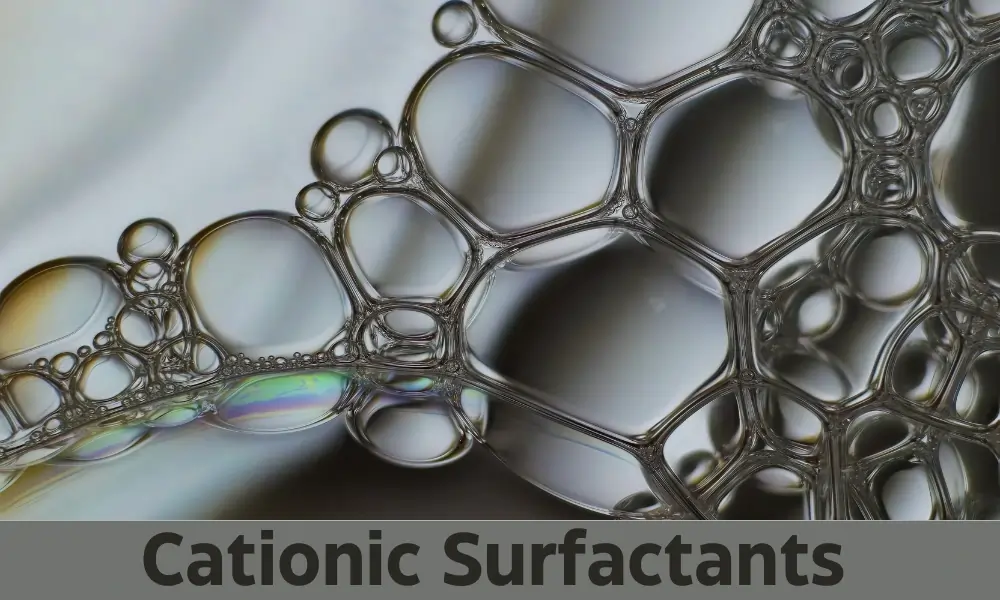Last updated on April 17th, 2025 at 03:22 am
When you mix your conditioner with water, the surfactant in it reduces the surface tension. This allows the product to spread more efficiently through your hair, creating a luxurious, lathering effect that enhances your shampoo routine.
Surfactants are essential chemical compounds found in almost all hair-washing products (conditioners, leave-in conditioner). These ingredients help cleanse and condition the hair, making sure your shampoo and rinse-out conditioner live up to what the packaging claims.
Surfactants also play a critical role in how products perform. The type of surfactant a manufacturer uses can greatly affect the overall impact on your scalp and how your hair looks and feels after washing.
In my experience, choosing the right type of surfactant can make a noticeable difference, especially for those with sensitive skin or specific hair needs. It’s not just about cleansing; it’s about maintaining healthy, vibrant strands.
Cationic Surfactants! Effective or Not?
Understanding surfactants in shampoos and conditioners is crucial, especially if you’ve experienced scalp irritation or dryness. Harsh sulfate-based surfactants can cause tightness and flakiness by stripping too much moisture. Switching to products with mild surfactants, like those containing saponins, can cleanse effectively without harsh effects. Natural shampoos and conditioners with amphoteric surfactants are recommended for sensitive skin, maintaining a healthy scalp. In conditioners, cationic surfactants smooth strands and reduce frizz, improving hair manageability. This switch can transform your hair care routine into a soothing experience.What are Surfactants?
In the realm of hair care, surfactants play a pivotal role. These are the agents that make our shampoos lather and our conditioners smooth. A surfactant molecule has two parts: hydrophobic and hydrophilic. The hydrophobic part is a hydrocarbon chain of variable length, typically between 8 to 18 carbon units. This length plays a crucial role in the balance of mildness and detergency of the product.
What Are the Surfactants Used in Hair Products?
Surfactants in hair products like shampoo and conditioner are designed to clean and improve hair health. These surfactants can be synthetic or natural and are chosen based on their properties to either remove oil and grease or to soften the hair.
Most shampoos use C12 surfactants, but the lengths can vary from C8 to C18 depending on the desired balance of mildness and cleaning ability. The hydrophilic and hydrophobic parts of the surfactant work together to effectively cleanse the scalp while being milder on the hair.
Types Of Surfactants
Anionic Surfactants
In the realm of hair care, anionic surfactants are widely recognized for their ability to remove oils from hair and scalp efficiently. These ingredients are a staple in two-in-one shampoos and conditioners, primarily due to their excellent lathering properties. However, it’s common knowledge that ingredients like sodium lauryl sulphate (SLS) can be somewhat harsh, tending to dry out the scalp.
Nonionic Surfactants
While nonionic surfactants are great at removing oil, they can be too drying for many hair types. These surfactants often strip the hair shaft of natural oils and moisture, which can lead to scalp irritation. To address this, some manufacturers opt for milder versions in shampoos and conditioners crafted for those with very oily hair. This careful balancing act contrasts nicely with the gentle, nourishing role of cationic surfactants in conditioners.
Cationic Surfactants
Cationic surfactants are a favorite in conditioners because they cling to the hair shaft and resist rinsing with water. These agents are highly effective in softening hair. A popular choice among manufacturers is polyquaternium-10, a cellulose-based polymer that can be adapted to create specific effects in hair conditioners. This adaptability allows for tailored hair care solutions that maintain moisture and manageability.
Amphoteric Surfactants
For those seeking a milder hair care formula, shampoos with amphoteric surfactants are a good option. These surfactants provide a decent lather without drying the hair and scalp. They commonly appear on the ingredients list of shampoos specifically designed for babies and young children, highlighting their gentle nature and suitability for sensitive users.
Are Surfactants Good or Bad for Your Hair?
When it comes to hair care, especially if you’ve ever dealt with scalp irritation or dryness, understanding the role of surfactants in shampoos and conditioners can be quite enlightening. Many of us have experienced that uncomfortable tightness or flakiness that can come from using a formula with harsh, sulfate-based surfactants. These ingredients are excellent at removing dirt and grease, but they can strip too much, leaving our Twisty Treasure feeling dry and our scalp irritated.
Switching to a product with mild surfactants, ones with a shorter hydrocarbon chain, can promote effective cleansing without the harsh effects. For instance, I’ve switched to using a natural shampoo and conditioner duo that features amphoteric surfactants—commonly recommended by dermatologists for those with sensitive skin.
These products often include active ingredients like saponins, natural compounds found in legumes and the roots of plants such as hawthorns. Saponins help to cleanse the hair while maintaining a skin-friendly pH level, ensuring that your scalp remains healthy.
I’ve personally found that Prose shampoos and conditioners, which contain non-sulfated surfactants, offer a much gentler experience. They produce a satisfying lather that cleans without the aftermath of dryness. This switch not only improved the health of my hair and scalp but also transformed my hair care routine into a more soothing experience.
Extra Ingredients for Cleansing and Moisturizing
When choosing shampoos and conditioners, it’s crucial to consider the surfactants and other active ingredients they contain. These ingredients are designed to cleanse and moisturize your hair, ensuring it stays healthy and free from dryness. The type of product you select depends heavily on the manufacturer and the specific benefits you’re seeking for your hair care routine.
Most hair care products feature a high water content, especially those that aren’t solid shampoo bars. They often include preservatives to extend shelf life and maintain the effectiveness of the moisturizing ingredients like glycerol, dimethicone, and cetyl alcohol.
However, many people are now opting for natural, paraben-free products due to concerns that parabens might affect hormonal levels. These natural alternatives not only help to soften the hair but also provide moisture protection by creating a protective film—thanks to components like acacia collagen.
This collagen helps safeguard both the hair shaft and the top layer of skin on your scalp, preventing oil overproduction and keeping your scalp healthy.
The Role of Surfactants in Curly Hair Conditioners
In conditioners, specifically, cationic surfactants are used primarily as conditioning agents. Their longer chains tend to increase mildness and provide lower lathering properties. This is because these molecules prefer to stay attached to the hair, smoothing out the strands and reducing static and frizz.
For someone who’s struggled with tangled and unmanageable hair, using a conditioner rich in these surfactants has been a game changer. It not only softens the hair but also enhances its manageability, thanks to these functional groups that cling to the hair, imparting their key properties.
How Cationic Surfactants Work?
In the realm of hair care products, cationic surfactants stand out due to their unique amphiphilic structure, which makes them excellent conditioning agents. Unlike their use in detergency, where they clean, in conditioners, they serve a more nurturing role.
When applied, these surfactants interact with the surface of the hair, particularly where the cuticle is damaged and carries a negative charge. The head groups of the surfactants form an electrostatic attraction with these negatively-charged sites, allowing them to adsorb effectively.
The hydrophobic portion of the surfactant molecule then lies flat against the surface of the hair, creating a film that smoothes the cuticle. This film not only enhances the tactile feel of the hair but also significantly reduces static and combing forces, making the hair easier to manage and less prone to tangle formation. Furthermore, for those with artificially dyed hair, these surfactants help in color retention, maintaining vibrancy and shine.
Through personal experience and detailed understanding of product formulation, I’ve seen how these agents transform hair texture and quality, making them indispensable in modern hair care solutions.
Cationic Surfactant Perform Multiple Functions
Cationic surfactants are not just additives; they are transformative agents in conditioners and shampoos. These surfactants have a unique ability to encapsulate hydrophobic additives, like silicones, and incorporate them into micellar structures.
When you rinse your hair in the shower, the water causes these structures to break down, leading to the deposition of conditioning agents onto the hair surface. This deposition enhances the formula, allowing the surfactant structure to serve multiple functions—both as an emulsion stabilizer and a conditioning agent.
These surfactants are effective as mild cleansers and excel as film-forming conditioning agents. The quaternary types are water soluble yet bind tightly to the hair, which might build up over time—a potential issue to watch for. However, the alkyl amines used typically show no significant drawbacks, making them suitable for everyone, including those with Twisty hair, who I’ve found to particularly enjoy their effects.
Conclusion
Cationic surfactants are an essential ingredient of any conditioner because of it tremendous properties. Overall there is no side effect to using the products having cationic surfactant in your hair care routine still it is good to do a patch test before use to avoid the chances of any allergy.
FAQs
Why is cationic surfactant used in conditioner?
Cationic surfactants are key because they cling to the hair shaft, making them resistant to rinsing with water. This action helps conditioners effectively smooth and protect your hair.
What are the cationic ingredients in hair conditioner?
Behentrimonium chloride and cetrimonium chloride are standout ingredients in conditioners and hair masks, helping to reduce static and frizz. These components make hair easier to detangle and style, transforming unruly locks into smooth, manageable tresses.
What surfactant is used in the conditioner?
Cocamido propyl betaine and cocamido betaine are the cationics most commonly used in conditioners to enhance hair smoothness and manageability.
What is an example of a cationic surfactant?
Examples of cationic surfactants include C8–10 alkyl hydroxyethyl dimethylammonium chloride and C8–10 alkylamidodimethyl propylamine, which is partially protonated at wash pH. These ingredients help conditioners work more effectively.

Dive into the world of curls with Farah, a celebrated curly hair expert whose passion and expertise have transformed her into a beacon for those seeking to embrace their natural hair texture. With a vibrant career spanning over a decade, Farah has dedicated herself to the science and art of curly hair, making her an authoritative voice in this niche. Her deep understanding of curly hair’s unique needs and challenges allows her to craft personalized care routines and styles that not only enhance the natural beauty of curls but also promote hair health.

